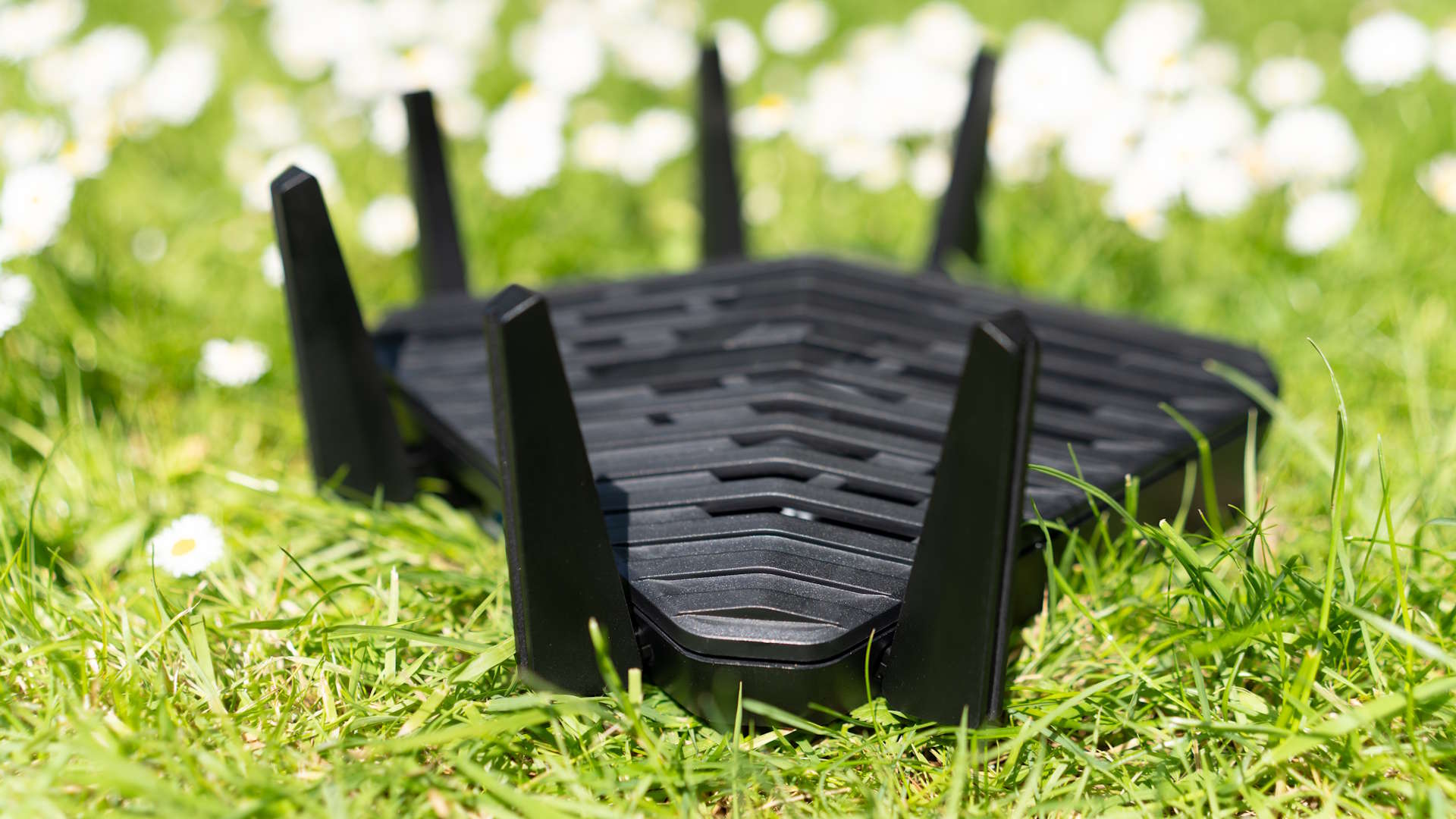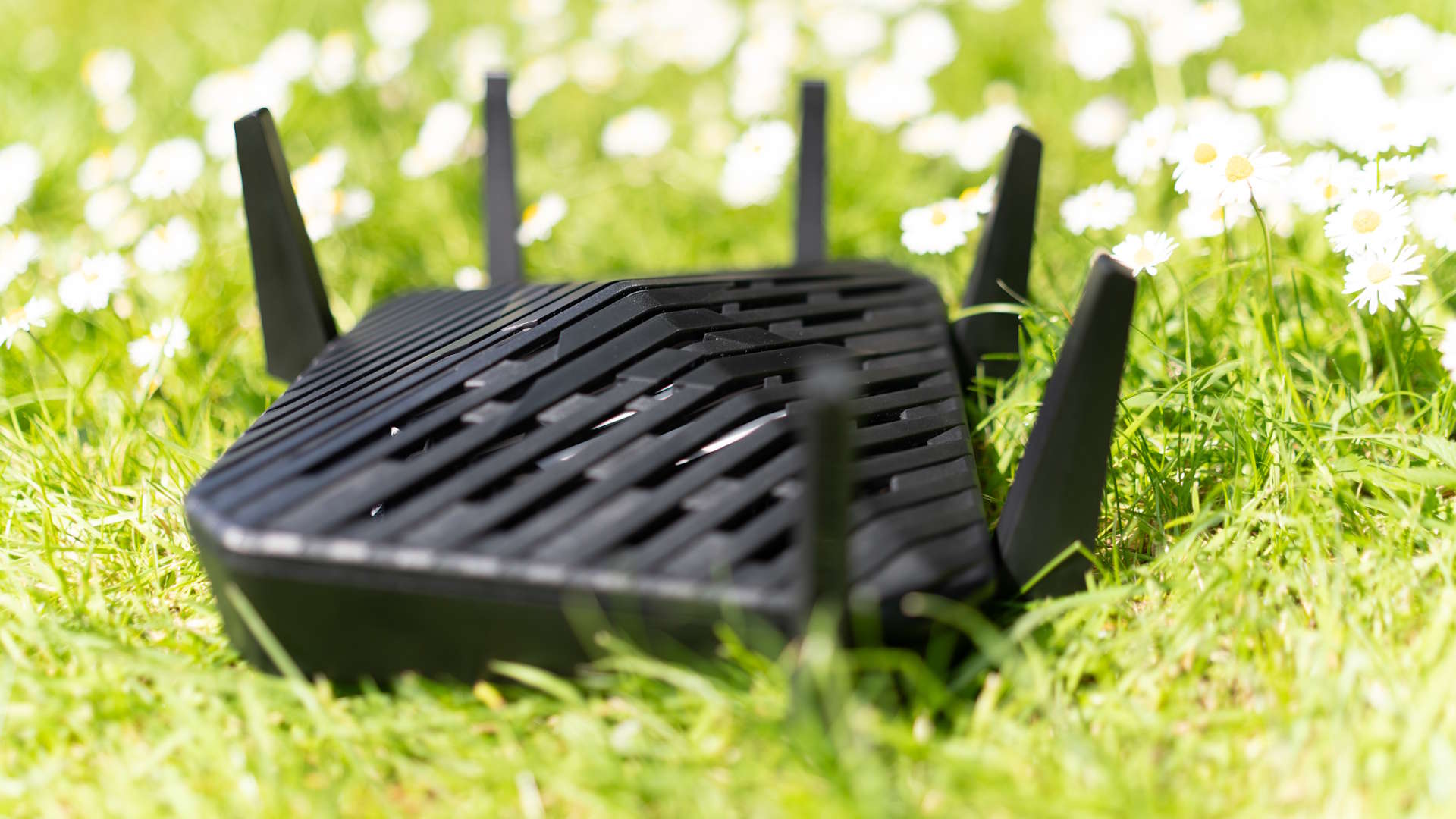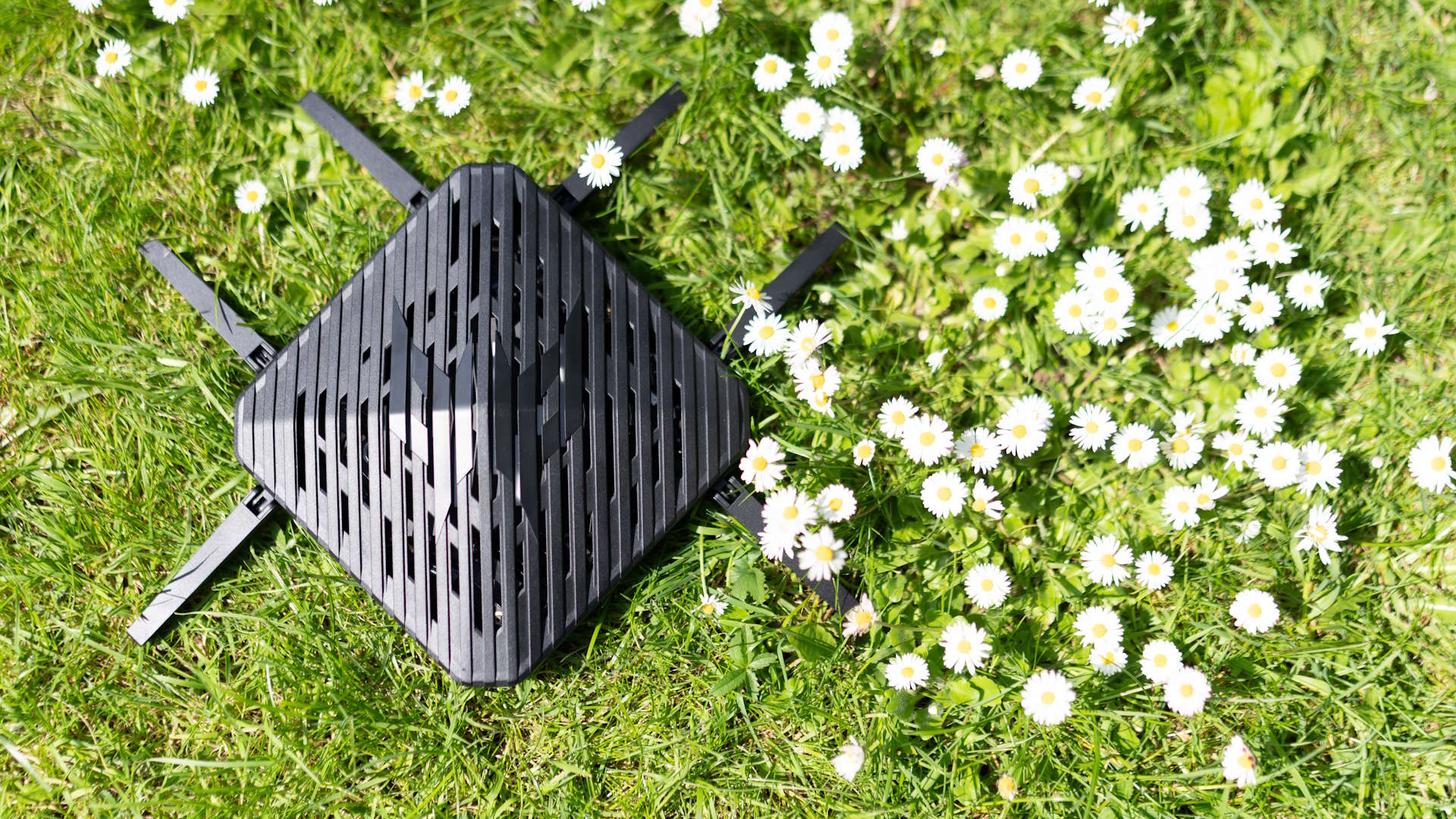Our Verdict
This Wi-Fi 6E router offers a high combined throughput number, but its real talent is in managing multiple streams of traffic, and prioritising gaming to lower latency. It's easy to set up and provides some excellent Wi-Fi coverage, but a quirk of its design means it's never going to blend easily into the background.
For
- Wi-Fi 6E
- Plenty of throughput
- Easy setup
Against
- Kinda large
- Kinda pricey
- Not Wi-Fi 7
PC Gamer's got your back
The upside-down insect look is a popular one among Wi-Fi router manufacturers, who seem to assume that they're something you're going to keep behind the couch or in a cupboard rather than attempt to balance on a narrow shelf near the point at which the internet cabling enters your home.
The aggressive styling can make these devices look incongruous among the other tasteful artefacts you've gathered from trips to Ikea and Habitat, though the use of words such as 'Predator' and 'Killer' don't help either. The names of PC hardware components have been the butt of multiple jokes, but networking equipment has to be some of the most boring kit to receive the kind of title you might expect from an Air Force drone.
Still, they're necessary if we insist on living in the early 21st century, streaming, downloading and otherwise internetting it up. And if you've got a fast fibre connection and the need to transfer data quickly, these so-called 'gaming routers' have a lot to offer.
Acer's Predator Connect W6 is a Wi-Fi 6E router with the requisite number of little leg pointed into the air (though it can also be wall-mounted, in which case the legs splay out further, giving it the appearance of a large bug that's just hit the paintwork at high speed). There are vents carved into the plastic body (the quad-core CPU is passively cooled), with some LEDs in the shape of the Predator logo buried underneath (these are quite bright, but can be turned off), and a row of five Ethernet ports at the back.

Wireless standard: Wi-Fi 6E
Max speeds: 600Mbps (2.4GHz), 4.8Gbps (5GHz), 2.4Gbps (6GHz)
MU-MIMO: Yes
Ethernet ports: Four gigabit, inc Game port
WAN: 2.5Gbps
Processor: 2.0GHz quad core
RAM: 1GB
USB: 1x USB 3.1 Type-A
Dimensions: 111 x 265 x 260mm
Weight: 875g
Price: $300 | £300
It's all very standard, though the design of the router means it takes up even more space than you'd expect from something that's basically square, as by having the power input and USB port on one side, and the Ethernet ports on another at 90° to that, you're forced to put it in a diamond configuration to keep the cables at the back.
One of those Ethernet ports is the input, and can take up to 2.5 Gbps of internets. This is, to use a technical term, a lot, and you'll be distributing it through four gigabit ports (one of which is a mysterious 'Game' port that claims to prioritise gaming traffic and is the one you'll want to plug your gaming desktop into) plus the Wi-Fi, which has a maximum throughput of 7.8 Gbps. That's a figure arrived at by manufacturers adding together the transfer rates of the router's three bands, rather than being rooted (or routed?) in reality.
As long as you have Wi-Fi 6E equipment to talk to it (plain old Wi-Fi 5 and 6 still do fine, but you'll lose out on the fancy 6GHz band, which can be handy for avoiding congestion) those theoretical speeds are yours to do with what you will. As you'll no doubt have noticed, this is way higher than any possible input, and outstrips average broadband speeds in the UK and US by 111 and 40 times respectively, but means the router won't be a bottleneck if you're transferring data between devices, gaming and streaming at the same time.
Happily, setup is a breeze. The wireless network is available straight away, and there's a QR code on the bottom of the router's casing to help you get connected via your web browser. From here, it's just a case of entering your WAN details, giving the Wi-Fi channels amusing SSIDs and changing the password. There's a phone app that you can use for all this too, which will step you through the setup in a more beginner-friendly way.
Once it's connected, there's a whole range of features to, er, play with. Networking isn't particularly sexy but it is essential for modern life, especially if you're a PC games enjoyer, so being able to easily slip into the admin panel and change a setting is paramount. That said, there's often little need these days, as routers have become very good at doing things automatically.



✅ You're looking to upgrade from an existing Wi-Fi 5 router: If you have the equipment to take advantage of Wi-Fi 6E's features, but not the router, Acer's Predator will do a job.
✅ You run a congested network: The game prioritisation will also come in handy if you've got a busy network and want to make sure your gaming traffic takes priority over movie streaming.
❌ You're trying to sleep in the same room: The light-up logo can be very bright. It also may take a few tries to find a home for, as the way the cables go into two different sides means there's no flat 'back' to put up against a wall.
To accompany the 'Game' port on the back, the Predator W6 offers QoS features ('compatible with Intel Killer Prioritization Engine,' so Acer crows) to prioritise your gaming traffic. It also includes a preset dedicated to GeForce Now which will appeal to, well, at least some people.
Otherwise, hooking up to a fibre connection (600Mbps in my case: not great, not terrible) by both Ethernet and Wi-Fi 6 leads to a stable connection and good throughput. Routers have been able to handle multiple connections and complicated network topography for some time now, so the fact it breezes through serving multiple streaming, gaming, and IoT uses simultaneously isn't anything unusual.
What routers are really sold on are their big numbers and their price. At £300/$300 there are cheaper Wi-Fi 6E models available, though few with as impressive a combined throughput figure (Netgear's RAXE300 hits the same combined speed, but its RRP is higher). If you want to upgrade from the router your ISP gave you, then the Predator W6 will probably make a big difference to a congested network with a lot of users.
But the way it's designed means that it wants a lot more attention than most of us are willing to give networking hardware within our homes. It may have Quality of Service features, but its quality of life layout is something that stops it from being an easy recommendation.
This Wi-Fi 6E router offers a high combined throughput number, but its real talent is in managing multiple streams of traffic, and prioritising gaming to lower latency. It's easy to set up and provides some excellent Wi-Fi coverage, but a quirk of its design means it's never going to blend easily into the background.

Ian Evenden has been doing this for far too long and should know better. The first issue of PC Gamer he read was probably issue 15, though it's a bit hazy, and there's nothing he doesn't know about tweaking interrupt requests for running Syndicate. He's worked for PC Format, Maximum PC, Edge, Creative Bloq, Gamesmaster, and anyone who'll have him. In his spare time he grows vegetables of prodigious size.


